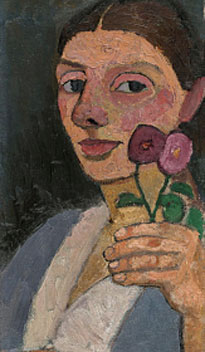9.9.24 — Who Am I?
“Ich bin Ich,” and of course she was, but Paula Modersohn-Becker had her doubts. The Neue Galerie takes the title of her retrospective, through September 9, from a letter to Rainer Maria Rilke, and it rings true for today.
I, a woman, am myself and no one else, she wrote, a boast for many a woman artist now—but who am I? She had just left her husband, Otto, restless for answers. She could not go back to the younger artist she had left behind, but what was the way ahead? She had every right to ask, and she died at just thirty-one,  on the brink of a new art form for a new century. Together with a recent report on Käthe Kollwitz and German Expressionism, it is also the subject of a longer and fuller review, in my latest upload.
on the brink of a new art form for a new century. Together with a recent report on Käthe Kollwitz and German Expressionism, it is also the subject of a longer and fuller review, in my latest upload.
How did German Expressionism arise in the first place? In her painfully brief career, Modersohn-Becker offers a snapshot of a crucial moment. She died of complications from childbirth (an embolism) in 1907, the very year of the museum’s most prized work, the woman in gold by Gustav Klimt. Almost its entire collection lay ahead. She had joined Worpswede, an artist colony not too far from her family home in Bremen, and studied in Berlin, with classical training in drawing from life. In repeated trips to Paris, she took in the latest exhibitions, but even more so the Louvre.
She admired Fauvism, but Henri Matisse and André Derain had returned from their summer by the sea barely a year before. Pablo Picasso was still a newcomer to Paris in Montmartre. Modersohn-Becker did not live to see World War I, which did so much to shape Max Beckmann, or the postwar decadence, turmoil and experiment that Hitler denounced as “degenerate art.” Everything for her was figure painting, even when it includes still life, and she was determined to make it modern. She left her own version of Klimt’s standing woman, with a similarly patterned backdrop, but she made it hers twice over, without the gold. It shows her and her alone, naked and pregnant.
She was painting affection, but with a frankness born of detachment and reserve. She paints herself repeatedly, in one case with a blank face. That self-portrait could be unfinished, but, hey, you never know. Often she holds up a flower, like a shield, because she deserves no less but can afford little more. She paints a mother and child, fleshy and caring, but neither friend, nor family, nor herself. She did reunite with Otto and give birth to a daughter, but the show’s only portrait of him, years earlier, brings him so close to the picture plane that his limbs become fragments.
Still, it an act of love, take it or leave it. At the very least, it is an act of respect from one artist to another. A room for work from just before 1890 accords peasants and workers that same respect. It also shows the discipline of classical drawing, in charcoal with bare accents of color, and what she had soon to give up. Her early subjects have distinct personalities, but modernizing for her soon meant something else again. From that point on, faces let on only discomfort at having to pose.
She begins taking things apart while building up flesh and paint to match. She also turns to children, they, too, cautiously holding flowers. She treasures those accents of color, which increasingly give a painting its focus. Still, she never fully gets over her muter early work. She may have liked Fauvism, but she prized Paul Gauguin more. She uses patches of brown much like his for shadows, to structure a figure and a painting.
In so short a career, it is hard to speak of artistic development, although Modersohn-Becker left behind more than seven hundred paintings and a thousand drawings. The show spans barely a decade, with no examples of her earliest work back in Bremen. (That work does allow the color clashes of Post-Impressionism.) She never did become the pioneering artist confident in her Ich and I. It does, though, leave her on the brink of something to come. Could that something be German Expressionism?
Read more, now in a feature-length article on this site.